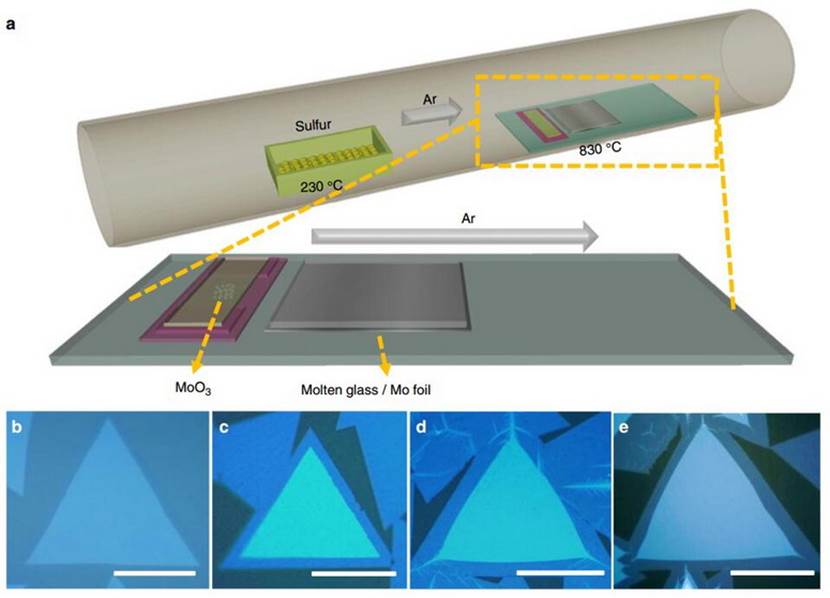Scalable high performance radio frequency electronics based on large domain bilayer MoS2
On November 14, 2018, Nature Communications published the research results of scalable high performance radio frequency electronics by Professor Yanqing Wu from Wuhan National High Magnetic Field Center. The paper entitled "Scalable high performance radio frequency electronics based on large domain bilayer MoS2". The co-first author of this paper is Qingguo Gao and Zhenfeng Zhang, PhD students of Grade 2014 and 2015 from school of optical and electronic information, respectively. The co-authors from group members including Xiaole Xu, Jian Song, and Xuefei Li.
Two-dimensional (2D) semiconductors have received great research attention for applications in the emerging ubiquitous electronics, such as sensors, memory, and logic field of applications owing to their atomically thin body and excellent carrier transport properties. Flexible electronics in wireless communication is one of the most promising field which has witnessed rapid development of flexible passive components and active components. However, despite tremendous interest in graphene transistors for active radio frequency (RF) components, it still remains a challenging issue that the gapless nature of graphene gives rise to poor current saturation and large output conductance in these transistors, which are detrimental for amplifying and mixing high frequency signals. Recently, great progress has been made on high frequency transistors and circuits based on 2D transition metal dichalcogenides, such as molybdenum disulfide (MoS2), where the key disadvantage of graphene can be overcome. Mechanically exfoliated MoS2 on quartz substrates has shown high extrinsic radio frequency performances.
In order to provide a low-cost scalable solution, large-area synthesis of MoS2 atomic films by chemical vapor deposition (CVD) was developed with progressive improvement by many research groups. Recently, RF transistors on flexible polyimide substrates based on monolayer MoS2 grown by CVD exhibited an extrinsic cut-off frequency fT of 2.7 GHz and maximum oscillation frequency fmax of 2.1 GHz and, furthermore, an extrinsic fT of 3.3 GHz and fmax of 9.8 GHz were demonstrated using an embedded gate structure on SiO2/Si substrates. However, these parameters are still well below the devices based on exfoliated MoS2, severely limiting their high frequency applications. It is well known that the carrier mobility of bilayer MoS2 is higher than that of monolayer and, as a result, better performance can be obtained owing to the higher density of states and smaller bandgap which is more suitable for high frequency electronics. However, bilayer MoS2 growth by CVD suffers from small domain sizes and poor mobility, restricting its device performance.
Here, high mobility large domain bilayer MoS2 growth by CVD on molten glass is realized by adjusting the weight of MoO3 precursor during growth. The largest domain size of 200 μm can be obtained and the resulting single-crystal triangular bilayer MoS2 demonstrates a room temperature electron mobility of 36 cm2 V-1 s-1. A back-gated MoS2 transistor with 40 nm channel length exhibits a record high ON-current (Ion) of 1.52 mA μm-1 at 4.3 K with optimized high-κ dielectrics. State-of-the-art RF transistors based on bilayer MoS2 are demonstrated with a record high extrinsic cut-off frequency fT of 7.2 GHz and maximum oscillation frequency fmax of 23 GHz. Moreover, MoS2 RF transistors and frequency mixers on flexible substrates are demonstrated with a fT of 4 GHz and fmax of 9 GHz where the mixer remains functional in gigahertz regime. This work demonstrates the potential of CVD bilayer MoS2 for high frequency applications and flexible wireless communication.
